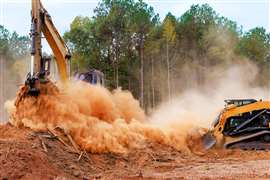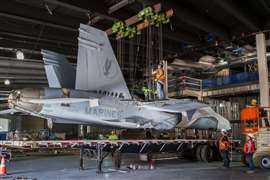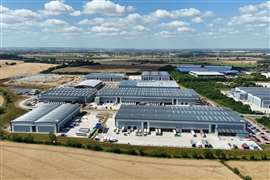Lifting and hauling at
04 March 2008
Sixty years ago, the group today known as the Specialized Carriers & Rigging Association began as a handful of US companies that moved and, sometimes, erected bulky objects. After World War II, changes in business methods and decentralisation brought about remarkable transformation in the transport of heavy machinery, other heavy objects and articles requiring the use of special equipment. Also changing were laws and regulations affecting the transport of such loads.
To accommodate the segment of the transport industry affected by these developments, the Local Cartage National Conference (LCNC) of the American Trucking Associations began the process of creating a new section in 1947. In December 1948 the Heavy Haulers, Machinery Movers and Erectors Section of LCNC was born.
Soon, a Red Book Division of LCNC became the Heavy and Specialized Carriers Section. The original name came from the Interchange Plan, stored in a red binder, which allowed companies that used specialized equipment to transport oversize items between all points in the US without transfer of lading or changes of equipment or driver.
In 1958 glaring differences in interests and needs led the Heavy and Specialized Carriers Section to petition ATA's Board of Directors to be considered as a separate conference within ATA. The reasons given for wanting to break away from LCNC were:
Members were involved in activities and services that went well beyond the scope of the term “local cartage.”
Although a number of non-affiliated heavy and specialized carriers wanted to affiliate with the Red Book Division, they had no interest in most LCNC activities.
The group felt the need to be identified other than “local cartage” in actions before the Interstate Commerce Commission and other federal regulatory agencies.
Separating the activities of the heavy and specialized carriers from the rest of LCNC would simplify financing and other administrative functions to prevent misunderstandings.
Going ahead
After ATA approved the plan, the new Heavy-Specialized Carriers Conference (HSCC) held its first official meeting on 6 December 1958 at the Mayflower Hotel, Washington, D.C. with 75 people in attendance.
In 1959 Frank Floyd elected to leave his position as LCNC general manager to become HSCC managing director & general counsel. Despite the split, LCNC and HSCC remained close in several ways. Staffs of the two organisations both were housed in offices of ATA's Washington, D.C. headquarters. Several members were officers of both groups.
HSCC grew steadily, attaining membership of 200 member companies by 1966 and 300 by 1968. The crane and rigging section of the conference played an increasingly important role. By the late 1960s, that section had groups working to change the crane safety code and equipment standards; produce the first standard crane rental agreement; and author the first standard rigging and erection, work and labour supply contracts.
HSCC had 400 members by 1972 and 500 by 1974. It also reached out to other countries, sponsoring the first International Business Forum to Europe in 1973.
When the Motor Carrier Act of 1980 rewrote the rules governing trucking, HSCC strongly opposed proposals that would unnecessarily complicate life for members. At the same time, HSCC demonstrated its commitment to safety, holding the first of a long series of Annual Safety Workshops.
HSCC also promoted a feeling of family among transport and crane and rigging members by adopting a new name in 1981: the Specialized Carriers and Rigging Association (SC&RA). In 1983, SC&RA established the SC&R Foundation, largely to fund industry-related research projects and scholarships.
The Steel-Carriers Conference of ATA merged with SC&RA in 1985. That year, SC&RA also relocated to ATA's new headquarters in Alexandria, Virginia.
In 1986 the annual Crane & Rigging Workshop doubled its attendees from the previous year by concentrating on practical topics for management. The next year, SC&RA sponsored the first Oversize/Overweight Transportation Symposium, which brought together for the first time professionals involved with the transport of over-dimensional loads, their suppliers, and state and federal highway officials.
Crane and transport policies
In 1988 the year began with SC&RA working to formulate policies on certification for crane operators and escort service companies. In 1991 SC&RA began the Escort Services Accreditation Program. SC&RA also initiated the Permit Uniformity Blitz, a programme that pinpointed 16 problem states over a three-year period.
To better serve a membership that had pushed above 700 companies, SC&RA moved from ATA headquarters in Alexandria, Virginia to more spacious offices in Fairfax in 1994.
The next year, SC&RA spun off an independent not-for-profit corporation to administer a nationwide programme of crane operator certification, the National Commission for the Certification of Crane Operators.
A major development in 1996 was the SRS Insurance and Risk Management Program, available exclusively to SC&RA members. The programme included a loss control package that helped SC&RA clients avoid injuries and property damage, aggressive claims investigation and a litigation control system. Backing it all was all-line coverage underwritten by AIG.
After the terrorist attacks on 11 September 2001, many SC&RA members stepped forward to assist in recovery and clean-up efforts. The industry, however, like most other segments of the economy, struggled through tough times over the next two to three years.
While rededicating itself to membership recruitment, the Association worked on programmes to retain members. Membership increased from 1,050 in 2003 to 1,300 in 2007.
Recent years also have been marked by a number of collaborative efforts with other organisations, including:
• The Crane & Derrick Negotiated Rulemaking Committee (C-DAC), a public-private effort dedicated to revise the US crane and derrick safety standard for the first time since 1971
• The National Highway Watch Program to support national security concerns
• Edison Electric Institute's programme to help SC&RA members get involved with efforts to restore service to utility customers in the event of deliberate destruction of utility substations
• U.S. Chamber of Commerce and American Trucking Associations campaigns to reform the US tort system
• SmartWay Transport Partnership, a public-private initiative that supports freight shippers, carriers and logistics companies in setting and achieving ambitious goals that increase fuel efficiency and reduce emission of greenhouse gases and air pollutants
• Drug-Free Workplace Alliance, an agreement between 13 contractor associations and unions organised by the U.S. Labor Department.
SC&RA entered 2008 with a full agenda. While reflecting on 60 years of progress, the Association will continue to move forward on its mission of “providing the unique information and other lawful activities worldwide members need to safely, legally and profitably transport, lift, and erect oversize and overweight items.”




